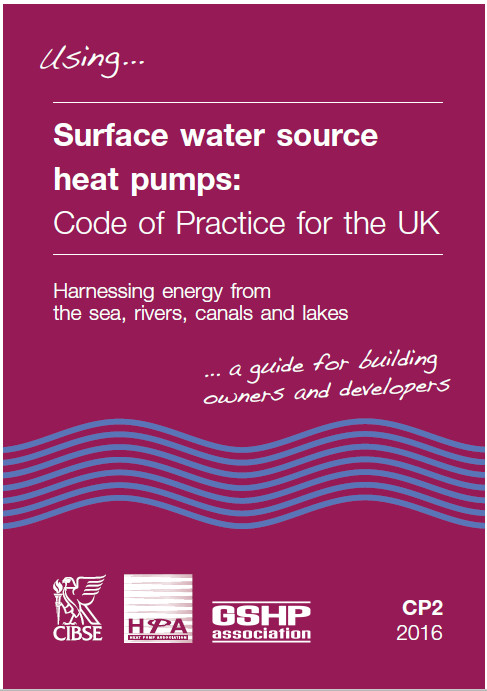Articles
Surface Water Source Heat Pumps
Surface water source heat pumps are an under-used technology in the UK. Harnessing renewable energy from the sea, rivers, canals and lakes represents a huge opportunity to provide low carbon heating and cooling to buildings.
A surface water source heat pumps Code of Practice has been produced jointly by CIBSE, the HPA and the GSHPA. The introduction to the Code states that:
-
Heat pumps can provide an efficient and low carbon means of using renewable heat from the sea, rivers, canals and lakes.
Although heat pump systems can be more expensive to install than conventional oil or gas combustion technology,
they deliver a cost effective return on investment, with significant potential benefits to the owner/developer
from moving to a more renewable solution.
Following the requirements in this Code of Practice will help achieve well-engineered installations
that provide these lower running costs and carbon emissions.
CP2 Surface Water Source Heat Pumps: Code of Practice
As well as providing a comprehensive description and checklist of the various elements of an installation – from feasibility, through design, construction, commissioning and operations – the Code includes a number of useful case studies of installations of surface water source heat pumps in England, Wales, Ireland and Norway.
The Code of Practice has being drawn up by CIBSE, the Heat Pump Association and the Ground Source Heat Pump Association, supported by DECC. It examines the options for extracting heat from surface water to provide heating and rejecting heat to open water to provide cooling. The aim is to provide developers with guidance on where SWSHPs can be used to provide large scale heat transfer in densely populated urban areas and raise the standards of design and implementation of water source heat pumps in district heating systems.
The Code, which has been produced by a steering committee with lead authorship from Nic Wincott of the GSHPA, can be bought from www.cibse.org/CP2. Electronic copies are available without charge to members of CIBSE, HPA and the GSHPA.
Meanwhile, a short leaflet explaining how the Code can be used by building owners and developers can be seen by clicking the image on the right.
Surface Water source heat pumps benefit from the thermal inertia of open water
A heat pump can concentrate heat by compressing refrigerant gases into a small volume and then transferring the heat into buildings to provide warmth via heat exchangers. The refrigerant gas becomes cold when the pressure is released and this coldness can be exchanged with warmer water from the river – and the cycle can be repeated continuously. The effect is to transfer heat from open water into buildings to heat them and provide domestic hot water.
Some interesting points to note:
- heat pumps are likely to become more common as the UK attempts to decarbonise its heating systems
- the use of heat pumps is growing as the government subsidises low-carbon heat sources with the Renewable Heat Incentive
- air source heat pumps, which heat exchange with ambient air, are cheaper to install than ground source heat pumps, but they are at their least efficient on the coldest days when they are most needed.
- The river is warmer than the air in winter, so a water source heat pump is more efficient than an air source heat pump – because of the thermal inertia of the water from the previous summer.
- The ground is also warmer than the air, so a ground source heat pump is also more efficient than an air source heat pump – because of the thermal inertia of the ground from the previous summer.
It is possible to go one major step further in exploiting the thermal inertia of the immovable thermal mass of the ground – by adding solar heat to the ground in summer in order to recycle the heat with a heat pump the following winter: Underground Thermal Energy Storage.
Advantages of Surface Water Source Heat Pumps
Water has a high capacity to hold heat in relation to its volume; it readily absorbs heat and readily delivers it: it enjoys a high transfer rate. It is more efficient for a heat pump to exchange heat with water than air – which enables a water source heat pump to outperform and air source heat pump. A ground source heat pump also uses water to transfer heat from the ground to its heat pump.
The thermal capacity and thermal inertia of water enables it to retain some of the solar heat gained in the summer through to the winter. River water, and ground water in aquifers, will be warmer than the air temperatures on cold winter days and thus provide a more attractive input temperature to a heat pump.
A well engineered water source heat pump system has access to a large volume of water: this enables it to extract heat from a very large heat source whose temperature will not change significantly as relatively small amounts of heat are extracted from it. For heat extraction from a flowing river there will be no change to the inlet temperature from the river if the discharge is downstream of the abstraction point.
Disadvantages of Surface Water Source Heat Pumps
The disadvantages of an open loop water source heat pump system include the need to meet the additional engineering challenges of dealing with open water which may contain debris, unstable pH values or biological growth and may call for additional pumping loads. It will also be necessary to meet the abstraction requirements of the Environmental Agency on all but the smallest of schemes. Most of these problems can be sidestepped by employing a closed loop system with heat exchangers immersed in the river or in open water.
The key disadvantage of using a very large body of water to achieve heat exchange with a relatively constant temperature is that you are not able to store summer heat in that body of water – to have the benefit of retrieving those higher temperatures in winter.
Heat pumps can play an important role in balancing supply and demand
It has been said that: "Heat pumps could also play an important role in balancing supply and demand in future energy systems. Electricity is difficult to store, but heat can be stored easily in the form of hot water."
In fact, heat pumps will be able to play a far more significant part when it is understood that heat pumps can do much more than store a small amount of heat overnight in small hot water tanks: heat pumps can play a significant part in interseasonal heat transfer systems when the ground itself can be used as a very large store of solar heat energy from summer to winter.
Electrification of Heat
There are now new ways of organising information and temperature to provide renewable heating and renewable cooling by recycling heat in district circuits.
The search for new techniques to control carbon emissions is advancing. There are alternatives to burning fossil fuels to keep us warm in winter – and cool in summer. The answer is to recycle heat between seasons and within districts – and by recycling heat it is also possible to provide heating without contributing to air pollution.
Demand Response and Distributed Heat Storage
The demand for electricity fluctuates during each 24 hour day. The supply of electricity also fluctuates, with photovoltaic cells generating electricity on clear days and wind turbines when the wind is blowing.
The National Grid must be able to guarantee power at times of peak demand.
"Demand Response" can be used to stimulate use of electricity at off-peak times (by lowering prices) and to discourage use of electricity at peak times (by increasing prices). Demand response goes hand-in-hand with temporary heat storage in insulated hot water cylinders: a low price signal can be used to trigger heat pumps to increase the temperature of DHW storage.
Surface Water Heat Pump Installation
The BEN Consortium has been involved in the design and installation of a surface water source heat pump at Robinson College, Cambridge.



